Related Research Articles

Elasmucha grisea, common name parent bug, is a species of shield bugs or stink bugs belonging to the family Acanthosomatidae. The term parent bugs includes also the other species of the genus Elasmucha and some species of the family Acanthosomatidae.

Pyrrhocoridae is a family of insects with more than 300 species world-wide. Many are red coloured and are known as red bugs and some species are called cotton stainers because their feeding activities leave an indelible yellow-brownish stain on cotton crops. A common species in parts of Europe is the firebug, and its genus name Pyrrhocoris and the family name are derived from the Greek roots for fire "pyrrho-" and bug "coris". Members of this family are often confused with, but can be quickly separated from, Lygaeidae by the lack of ocelli on the top of the head.

The brown marmorated stink bug is an insect in the family Pentatomidae, native to China, Japan, Korea and other Asian regions. In September 1998 it was collected in Allentown, Pennsylvania, where it is believed to have been accidentally introduced. The nymphs and adults of the brown marmorated stink bug feed on over 100 species of plants, including many agricultural crops, and by 2010–11 had become a season-long pest in orchards in the Eastern United States. In 2010, in the Mid-Atlantic United States, $37 million in apple crops were lost, and some stone fruit growers lost more than 90% of their crops. Since the 2010s, the bug has spread to the nation of Georgia and Turkey and caused extensive damage to hazelnut production. It is now established in many parts of North America, and has recently become established in Europe and South America.

The hawthorn shield bug is a common European shield bug. Its chief food is haws, the fruit of the hawthorn tree, but adults can overwinter on a diet of leaves, and individuals can be found on many potential food plants, including pedunculate oak, sessile oak and whitebeam. They may grow up to 17 mm (0.67 in) long, and are camouflaged in shades of green and brown. Like many so-called "stink bugs", they may release unpleasant odours when disturbed.

The harlequin cabbage bug, also known as calico bug, fire bug or harlequin bug, is a black stinkbug of the family Pentatomidae, brilliantly marked with red, orange, yellow and white markings. It is a major pest of cabbage and related crops in the Brassicaceae, as well as the ornamental flower cleome throughout tropical and North America, especially the warmer parts of the United States. Nymphs are active during the summer and in the tropics the bug can achieve three to six generations a year. In the northern range there is only one generation annually and the insects overwinter as adults in crop residues or field edges. Organic control involves hand-picking the insects off the plants and being especially careful to remove and destroy all the eggs, which are black-and-white striped, laid in clutches of twelve.

Graphosoma italicum is a species of shield bug in the family Pentatomidae. It is also known as the Striped bug and Minstrel bug.

Carpocoris mediterraneus, the red shield bug, is a species of shield bug in the family Pentatomidae.

Gymnosoma rotundatum is a parasitoid fly found in Great Britain and Ireland.
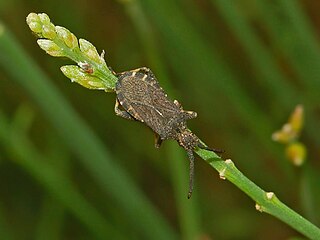
Bothrostethus annulipes is a species of Coreidae family, subfamily Pseudophloeinae.
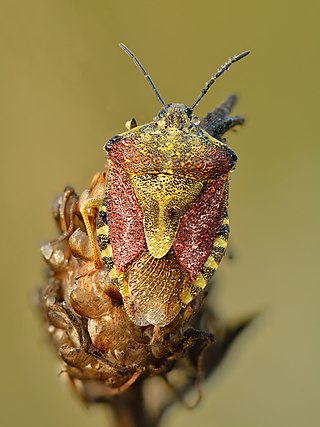
Carpocoris purpureipennis is a species of shield bug of the family Pentatomidae, subfamily Pentatominae.

The Dinidoridae are a small family of insects comprising about a hundred species in sixteen genera in the Hemipteran suborder Heteroptera, the "true bugs". As a group the family does not have any common name. Until the late 19th century they were generally regarded as a subfamily of the Pentatomidae.

Cosmopepla lintneriana, the twice-stabbed stink bug, is a species of insect in the family Pentatomidae. Cosmopepla lintneriana was first described in 1798 by Johan Christian Fabricius as Cimex carnifex, and then again in 1865 by Thomas Say as Cosmopepla bimaculata. Cosmopepla lintneriana is hosted by a variety of plants, including milk thistle, echinacea, asparagus, oats, mint and goldenrod, and is widespread throughout North America, from Canada to Mexico. Adult C. lintneriana are black with a red, orange, or yellow band across the pronotum and a short red stripe along the midline, and two red spots at the apex of the scutellum. Nymph coloration ranges from red to white with black markings that change as they grow.

Peribalus strictus, common name Vernal Shieldbug, is a species of shield bugs in the family Pentatomidae.
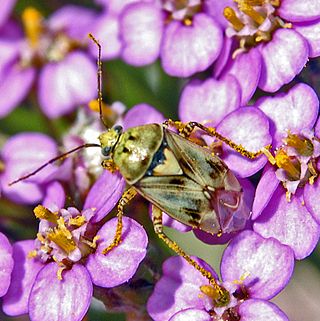
Lygus gemellatus is a species of plant-feeding insects in the family Miridae.

Mormidea lugens is a species of stink bug in the family Pentatomidae found in the Caribbean, Central America, and Eastern North America. In Illinois, adults have been observed emerging from overwintering sites in late April, and continue to be observed until early November, and appear to be bivoltine in this area. Eggs are approximately 0.7 millimetres (0.028 in) in diameter, pale yellow, and laid in small clusters of 6 to 11 eggs. Adults are bronze in color, with a white-yellow border around the scutellum, and are 5.0–7.2 millimetres (0.20–0.28 in) in length. In laboratory conditions, at approximately 24 °C (75 °F), development from eggs to adults has been documented to take between 39 and 50 days, and appears to be affected by the species of host plant. Mormidea lugens has been documented to feed on timothy, sedges, as well as deer-tongue grass, and Bosc's panic-grass. It has been collected from pale sedge and wide-leaved spiderwort but has not observed feeding on these species, and deer-tongue grass appears to be an insufficient food source for development.

Proxys punctulatus, the black stink bug, is a species of stink bug in the family Pentatomidae. It is found in the Caribbean Sea, Central America, and North America.
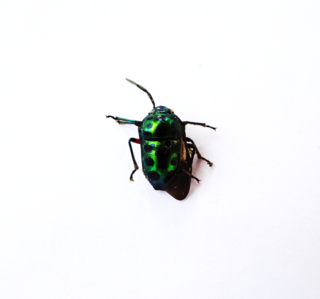
Chrysocoris patricius is a jewel bug in the family Scutelleridae. It is the smallest known species from the genus Chrysocoris.

Cyclopelta siccifolia is a bug in the family Dinidoridae found in South Asia. It is known for its large aggregations on certain species of plants. They have been known to aggregate and damage Erythrina, Sesbania, Pongamia, and Cajanus cajan.
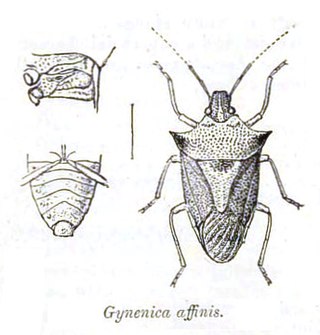
Gynenica is a genus of stink bug with about fourteen species in the Afrotropical and Oriental regions. It is one of four genera placed in the tribe Lestonocorini along with Lestonocoris, Neogynenica, and Umgababa that occur in Africa and India and feed on plants in the family Acanthaceae. Bugs in the genus have the pronotum tips extended into forward and upward curving spines. The scutellum is longer than broad, the apex with a rounded point and not reaching beyond the middle of the abdomen.
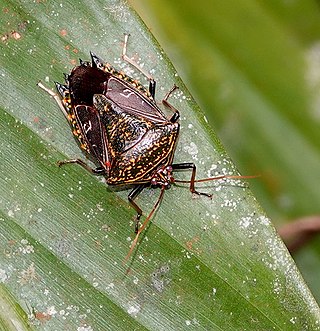
Pygoda poecila is a species of stink bug in the family Pentatomidae. It was first described in 2018 and is found in Central America. Its scientific name is in reference to the mottled body.
References
- 1 2 Thakur, N.S.A.; Firake, D.M. (2012). "Ochrophora montana (Distant): a precious dietary supplement during famine in northeastern Himalaya" (PDF). Current Science. 102 (6): 845–846.
- 1 2 Sharanabasappa, M.; Lavanya, N.; Kalleshwaraswamy, C. M.; Shivanna, B. K. (2018). "Udonga montana (distant) (hemiptera: pentatomidae), and it's swarming on forest plants in Shivamogga district". Indian Journal of Entomology. 80 (1): 102. doi:10.5958/0974-8172.2018.00020.2. ISSN 0367-8288.
- ↑ Patil, Roopa S.; Gowda, Javare; Hanumantha, M.; Raghunatha, R.; Shivashenkaramurthy, M. (2016). "Outbreak of Udonga montana Distant (Hemiptera: Pentatomidae), A Seed Bug of Bamboo in Canara Forest Circle, Karnataka". Indian Forester. 142 (3).